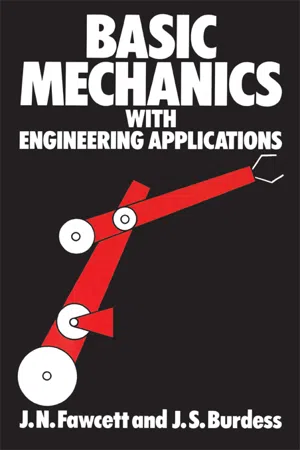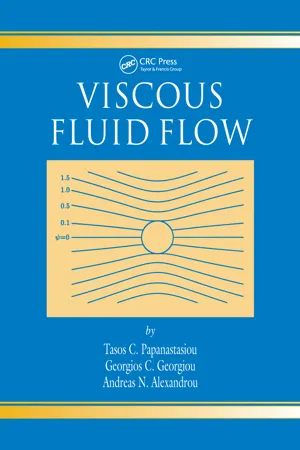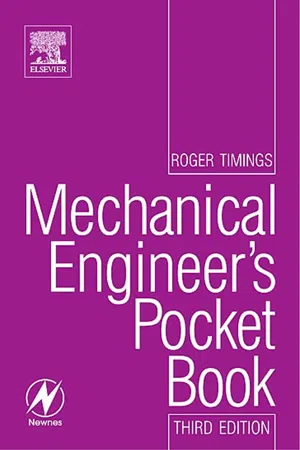Physics
Static Equilibrium
Static equilibrium refers to the state of an object when it is at rest and experiences no net force or torque. In this state, the object's linear and rotational velocities are zero. It occurs when the sum of all forces and torques acting on the object is balanced, resulting in no acceleration or change in angular velocity.
Written by Perlego with AI-assistance
Related key terms
Related key terms
1 of 4
Related key terms
1 of 3
8 Key excerpts on "Static Equilibrium"
- eBook - ePub
- J Jones, J Burdess, J Fawcett(Authors)
- 2012(Publication Date)
- Routledge(Publisher)
3StaticsBasic Theory3.1 IntroductionThe study of the special case of Newton’s Second Law in which the acceleration of the particle is zero is referred to as Statics. In these circumstances the resultant force acting on the particle must be zero so that, from eqn (2.1),Usually statics is concerned with systems which are at rest, although the results do apply to systems which are moving with constant velocity. (Remember that velocity is a vector quantity and for it to remain constant neither its direction nor its magnitude must change.)We will first consider the case of a particle, to which Newton’s Laws apply directly, and then consider the statics of rigid bodies.3.2 Equilibrium of a particle in a planeConsider a particle P in the XY plane of Fig. 3.1 with forces F1 … Fi… Fnapplied to it as shown. For the particle to be in a state of equilibrium, i.e. to have zero acceleration, eqn (3.1) givesFIG . 3.1Each of the forces FHence eqn (3.2) may be rewritten in component form asimay be expressed in components along OX and OY asIt has been shown in Chapter 1 that a particle moving in a plane has two degrees of freedom. Equations (3.4) show that the motion of the particle along the two co-ordinate directions corresponding to these two degrees of freedom is suppressed. Its equilibrium is therefore defined by two equations, one corresponding to each of the degrees of freedom.If a particle P is in equilibrium under the action of the four forces shown in Fig. 3.2(a) , the resultant of these forces must be zero, i.e.FIG . 3.2These forces can be added together using the rules of vector addition given in Chapter 1 (p. 2). The polygon of Fig. 3.2(b) - eBook - ePub
- Tasos Papanastasiou, Georgios Georgiou, Andreas N. Alexandrou(Authors)
- 2021(Publication Date)
- CRC Press(Publisher)
Chapter 4Static Equilibrium OF FLUIDS AND INTERFACE
Fluids considered as continuum media are in Static Equilibrium when, independently of any stationary or moving frame of reference, there is no relative motion between any of their parts. Since, by definition, a fluid cannot support shear stresses without deforming continuously, Static Equilibrium is characterized by the absence of shear stresses or any other mechanism that gives rise to relative motion. Consequently, velocity gradients in Static Equilibrium do not exist. According to these definitions, a fluid is under Static Equilibrium even if it is subjected to a rigid-body translation and/or rotation, since these types of bulk motion do not involve relative motion between parts of the fluid. In fact, for these motions there is a reference frame moving and/or rotating with the velocity of the rigid-body motion such that the velocity of any part of the liquid with respect to the frame of reference is zero. Therefore, the only velocity and acceleration that can exist under Static Equilibrium are uniform and common to all parts of the fluid.The lack of velocity gradients in Static Equilibrium implies that the only stress present is an isotropic pressure that is normal to fluid surfaces of any orientation. The pressure develops due to body forces, such as gravity and centrifugal forces, that counterbalance contact forces. The equilibrium between these forces is expressed by the hydrostatic equation. In Static Equilibrium, the state of stress is characterized by a diagonal stress tensor with components identical to the negative value of the pressure. Moreover, the mechanical pressure is identical to the thermodynamic pressure - eBook - ePub
- A. L. Stanford, J. M. Tanner(Authors)
- 2014(Publication Date)
- Academic Press(Publisher)
Newton’s second law, Σ F = m a, incorporates the fact that a static body, since it is not moving and therefore has no acceleration, has no net force acting on it. This is a condition of Static Equilibrium. We now know, however, that a body may have a net force equal to zero yet may not be static; it may, in fact, be undergoing rotation (look at Figure 4.14[a], for example). Consequently, for a body to be in Static Equilibrium, we must impose an additional condition: The net torque on the body must be zero. Here we may ask, “About what axis should the torques on the body be calculated? About what axis is the net torque equal to zero?” These questions may be answered by a question, “About what axis is the body not rotating?” Clearly, if the body is static, it is not rotating about any axis. Therefore, the net torque on a static body caused by all the forces on that body must be equal to zero when calculated using any axis. This condition, which pertains to any axis, may be expressed by Σ τ = 0 (4-33) (4-33) This means that, for any given arbitrary axis, all the forces acting on a body in Static Equilibrium produce torques about that axis, the magnitudes of which sum algebraically to zero. An astute reader could ask about a body in Static Equilibrium, “How do 1 know that if the torques sum to zero about a given axis and the forces sum to zero, the torques will sum to zero about any other axis?” We have not addressed this point, but Problem 4.47 provides the opportunity to convince yourself of its validity. A body in Static Equilibrium, then, is subject to two conditions of equilibrium, both of which must be satisfied - eBook - ePub
- A. D. Johnson(Author)
- 2017(Publication Date)
- CRC Press(Publisher)
Fig. 4.31 Types of contact force.4.8 Equilibrium Synopsis
Equilibrium was introduced and explained in section 4.4. It is essential to understand the importance of equilibrium since it is the basis for all the calculations performed in this chapter. Indeed it is also at the heart of analysis of many other branches of science, such as thermodynamics, fluid dynamics, kinematics, stress, electronics, chemistry, etc.The general assumption made in this chapter is that if a system is in equilibrium it must be static. However, there are many situations where the system does not have to be stationary for equilibrium to apply, but the motion must be uniformWithin the scope of this chapter the use of the principles of equilibrium allows the balancing of action forces and moments with reaction forces and moments. For this to be true, force systems have to be considered as static. If these systems were unbalanced they would move, that is, they would be ‘dynamic systems’ and other, appropriate theory would be required.Generally, the following ‘rules of equilibrium’ may be -applied to any force/moment system:- The vector sum of the forces must equal zero, i.e.
∑ F = 0where F represents vector forces.
- The algebraic sum of all the moments must equal zero, i.e.
∑ M = 0
- The algebraic sum of the vertical forces equals zero, i.e.
∑F v= 0where F v represents vertical forces.
- The algebraic sum of the horizontal forces equals zero, i.e.
∑F H= 0where F H represents horizontal forces.
4.9 Summary
4.9.1 Polygon of forces
When four or more forces, acting through a single point, are in equilibrium, the magnitudes and directions of these forces can be represented on a vector diagram which forms the sides of a polygon. All the forces must lie in one plane and must be considered in cyclic order.Note: this rule also covers, in a general way, the triangle of forces and the parallelogram of forces.For any vector diagram, for equilibrium, the vector diagram must close. For equilibrium the vector sum of the forces must equal zero, or - eBook - ePub
Analysis of Structures
An Introduction Including Numerical Methods
- Joe G. Eisley, Antony M. Waas(Authors)
- 2011(Publication Date)
- Wiley(Publisher)
2 Static Equilibrium 2.1 IntroductionWhile all solid bodies deform to some extent under loads these deformations are often so small that the bodies may be considered to be rigid for certain purposes. A rigid body is an idealization that considers a body to have no deformation when subject to loads. When all forces, both known applied forces and unknown restraint forces, are identified and we attempt to sum the forces and moments we can have two possible situations:1. The number of unknown forces is less than the number of independent equations of motion. Rigid body motion may result. This is the subject of rigid body dynamics . We shall not study this case here.2. The number of unknown forces is equal to or greater than the number of independent equations of motion. There is no rigid body motion and we have Static Equilibrium . There are two subcases:a. The body is statically determinate when the number of unknown forces is equal to the number of independent equations of Static Equilibrium. All the unknown forces can be determined by the summation of forces and moments without regard to what the body is made of or to its deformation.b. The body is statically indeterminate when the number of unknown forces is greater than the number of independent equations of Static Equilibrium. The summation of forces and moments is not sufficient to find the unknown forces. We need to consider the deformation of the body and the physical properties that contribute to resisting deformation.In the case of a statically indeterminate body we must introduce additional equations to obtain a solution. In this chapter we shall be interested primarily in statically determinate bodies. The subsequent chapters will contend with both statically determinate and statically indeterminate problems.2.2 Free Body DiagramsWe shall illustrate each subcase with a simple example in two dimensions using concentrated forces only. In these examples it is assumed that the applied forces initially are known and the restraint forces are unknown. - eBook - ePub
- Roger Timings(Author)
- 2005(Publication Date)
- Newnes(Publisher)
2Engineering Statics
2.1 Engineering statics
Engineering mechanics can be divided into statics and dynamics . Basically, statics is the study of forces and their effects in equilibrium, whereas dynamics is the study of objects in motion.2.2 Mass, force and weight
2.2.1 Mass
• Mass is the quantity of matter in a body. It is the sum total of the masses of all the subatomic particles in that body.• Matter occupies space and can be solid, liquid or gaseous.•Unless matter is added to or removed from a body, the mass of that body never varies. It is constant under all conditions. There are as many atoms in a kilogram of, say, metal on the moon as there are in the same kilogram of metal on planet Earth. However, that kilogram of metal will weigh less on the moon than on planet Earth (see Section 2.2.4 ).•The basic unit of mass is the kilogram (kg). The most commonly used multiple of this basic unit is the tonne (1000 kg) and the most commonly used sub-multiple is the gram (0.001 kg).2.2.2 Force
To understand how mass and weight are related it is necessary to consider the concept of force . A force or a system of forces cannot be seen; only the effect of a force or a system of forces can be seen. That is:• A force can change or try to change the shape of an object.•A force can move or try to move a body that is at rest. If the magnitude of the force is sufficiently great it will cause the body to move in the direction of the application of the force. If the force is of insufficient magnitude to overcome the resistance to movement it will still try to move the body, albeit unsuccessfully.• A force can change or try to change the motion of a body that is already moving. For example: - eBook - ePub
- W. Bolton(Author)
- 2015(Publication Date)
- Routledge(Publisher)
Chapter 2 Statics2.1 Introduction
Statics is concerned with the equilibrium of bodies under the action of forces. Thus, this chapter deals with situations where forces are in equilibrium and the determination of resultant forces and their moments.2.1.1 Scalar and vector quantities
Scalar quantities can be fully defined by just a number; mass is an example of a scalar quantity. To specify a scalar quantity all we need to do is give a single number to represent its size. Quantities for which both the size and direction have to be specified are termed vectors . For example, force is a vector and if we want to know the effect of, say, a 100 N force then we need to know in which direction the force is acting. To specify a vector quantity we need to indicate both size and direction. To represent vector quantities on a diagram we use arrows. The length of the arrow is chosen according to some scale to represent the size of the vector and the direction of the arrow, with reference to some reference direction, the direction of the vector, e.g. Figure 2.1 to represent a force of 300 N acting in a north-east direction from A to B.Figure 2.1 A vectorIn order to clearly indicate in texts when we are referring to a vector quantity, rather than a scalar or just the size of a vector quantity, it is common practice to use a bold letter such as a , or when hand-written by underlining the symbol a . When we are referring to the vector acting in directly the opposite direction to a , we would use -a , with the minus sign being used to indicate that it is in the opposite direction to a . If we want to just refer to the size of a we write a .2.1.2 Internal and external forces
The term external forces is used for the forces applied to an object from outside (by some other object). The term internal forces is used for the forces induced in the object to counteract the externally applied forces (Figure 2.2 ). To illustrate this, consider a strip of rubber being stretched. External forces are applied to the rubber to stretch it. The stretching pulls the atoms in the rubber further apart and they exert forces inside the material to resist this; these are the internal forces. The existence of the internal forces is apparent when the strip of rubber is released; it contracts from its extended length under the action of the internal forces. The internal force produced as a result of an applied external force is a force produced in reaction to their application and so is often called the reactive force or reaction - eBook - ePub
Energy, Entropy and Engines
An Introduction to Thermodynamics
- Sanjeev Chandra(Author)
- 2016(Publication Date)
- Wiley(Publisher)
When we place an empty bucket under a running tap it fills with water until it is brimming over. Then, if the tap continues to run, the rate at which water spills out equals the rate at which it flows in and the system has reached steady state. The mass of water in the bucket remains constant even though there is constant flow through it.2.8 Equilibrium
Drop a rubber ball on the ground and it will start bouncing (Figure 2.13 a). Each bounce will get progressively smaller and eventually the ball will stop moving and remain at rest until it is disturbed again. Place a hot piece of metal inside a rigid, insulated box (which is an isolated system) and it will start to cool until its temperature is the same as that of the air in the box, after which it does not change further (Figure 2.13 b). All physical systems that are left isolated eventually reach a state of equilibrium where their properties do not change with time. External intervention is necessary to change the properties of a system once it reaches equilibrium.(a) A ball bounces until it comes to rest and reaches equilibrium. (b) A heated metal rod in an insulated box loses heat until it reaches equilibrium when the temperature everywhere in the box is uniform.Figure 2.13The opposite of an equilibrium state is a non-equilibrium state, where the properties of an isolated system change spontaneously. A metal piece cooling inside a sealed, insulated box is a isolated system that is in non-equilibrium as long as the temperature of the metal and air continue to change.If we disturb a system in equilibrium it will pass through a stage of non-equilibrium until it reaches a new equilibrium state. A ball at rest on a table is at equilibrium, but pushed off the edge it will fall and bounce on the floor until it is comes to rest again. The transition from one equilibrium state to another is important because we can use the system to do useful work while it is in non-equilibrium. A ball cannot lift a weight while it is resting on a table or on the floor, but we could design a mechanism that uses the momentum of the ball while it is falling to do work. A tranquil lake cannot drive a hydroelectric turbine but a waterfall can.
Index pages curate the most relevant extracts from our library of academic textbooks. They’ve been created using an in-house natural language model (NLM), each adding context and meaning to key research topics.
Explore more topic indexes
Explore more topic indexes
1 of 6
Explore more topic indexes
1 of 4







